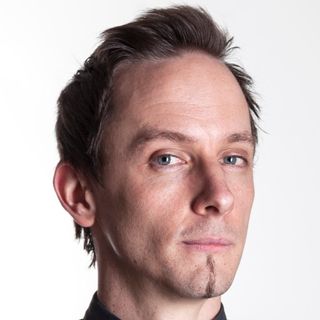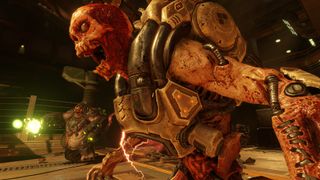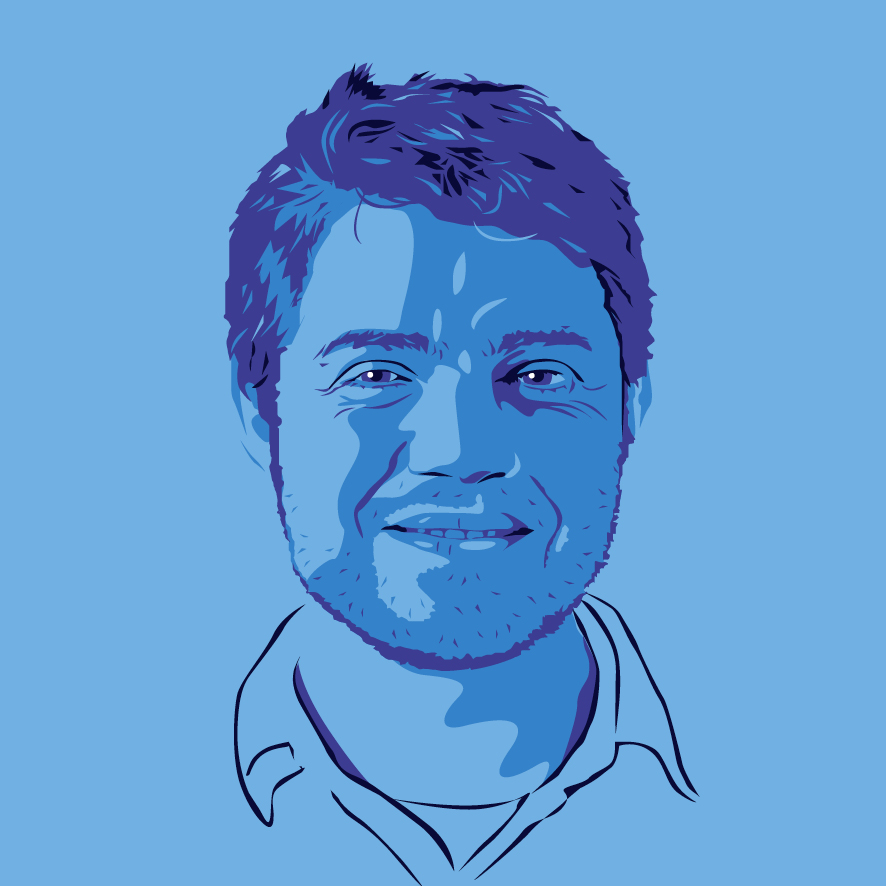Doom composer Mick Gordon: "one of the pre-conditions of the project was no metal"
A chat about dissonance, making music responsive, and how Doom 2016 ended up getting a metal soundtrack.


Mick Gordon is the composer for Doom, and has worked on Wolfenstein: The New Order, Killer Instinct 2014, and several Need For Speed games. Based in Australia, he's currently working on Arkane Studios' Prey reboot.
Back when Bethesda and id Software were making announcements about the recently rebooted Doom, one of the hints that it might end up decent was confirmation that Mick Gordon was onboard to compose the soundtrack. His work on Wolfenstein: The New Order and Killer Instinct is cherished among those games’ playerbases, and the intensity of both owe a lot to his anarchic (but still impressively subtle, when it needs to be) approach to getting visuals and music swinging to the same beat.
Based in Australia, Gordon’s been around for a while. He’s worked on two Need For Speed games, as well as Shift 2 Unleashed and ShootMania Storm, to name a few examples. Currently he’s working with Arkane Studios on its Prey reboot, which—as he relates below—will mark a departure from his recent, foot-to-the-floor audio rampages.
PC Gamer: Since you’re based in Australia, how did you get started in the industry?
Mick Gordon: It’s interesting, I started about 12 years ago and, at that time, there were about 40 companies making video games in Australia, and there were very few people doing sound. It was cool because I was able to contact people who lived in the same town as me – which was Brisbane at the time – and back then we had Pandemic, the THQ studio, and quite a few others. I started making music at home on little computer setups, sending it around to developers. For the [local studios], it made sense because they were able to work with someone local versus someone overseas. That’s kinda how it started.
Did you always want to compose for games? Did you play in bands or work in other fields beforehand?
I started playing in bands when I was 12. I was in pubs at 13, out the back playing rock songs and all that sort of stuff. It was good because it was a good education in learning what works for an audience, basically. That was really my only education in music. I did guitar lessons and things like that, but I never studied anywhere. When I left that world, I still wanted to do something in music because I really couldn’t do anything else. I wasn’t quite there for film, and I wasn’t quite there for pop music or rock music or any of that kind of thing – that world scared me a bit. Videogames were staring me in the face. I’d always played videogames, I grew up with them, so it seemed like a logical thing.
The original Doom soundtrack was heavily inspired by thrash metal. What inspired your direction for Doom 2016? Could there potentially have been another direction in which to take it, aside from industrial metal?
Comic deals, prizes and latest news
Sign up to get the best content of the week, and great gaming deals, as picked by the editors.
It’s interesting. I went over to Dallas for a couple of days and hung out with the id Software guys. That’s an incredible studio to visit because they’ve got this glass cabinet with all these original clay sculptures from the original Doom. It was amazing.
When I was there, we talked about what their direction for Doom was. The first thing you’ve got to do on a project like this is literally strike out the word ‘Doom’. You can look at the past, but if you get hung up on the fact that it’s Doom, you get caught up trying to remake what’s already been done. I have a good friend who’s a guitar player in Meshuggah, who said something interesting to me once: “why would you do something that someone else has done before? It already exists. It’s already out there”. So we sat down with Marty [Stratton, Doom game director] and Chris Hite [audio director] and talked about their approach to this game. Yes, it was called Doom, but what was this [particular] game [going to be]?
They said it was a very high impact, quick, violent, visceral, shooting experience that was all based around movement. A lot of games have taken a similar approach to cover-based shooting, which has been a thing for a while, but Doom really wanted to break that and get back to moving around. It was interesting, I played a very early version of Doom at that point and, amazingly, it didn’t look anything like Doom whatsoever, but it felt like Doom. They’d nailed the movement back then, and that was really quite interesting.
So we focused on those elements, the fact that it was quick and fast and in your face, then I looked at the aesthetic choices they’d made. They’re on the Mars base, so there are deep industrial factories and molten rock—it’s an isolating environment. Hugo [Martin, art director] talked very much about a high fidelity of information. That sort of stuff I wanted to get into the music and not just go straight down that ‘90s thrash metal tribute thing.

Mixing electronic music with metal has a mixed history, but you’ve done it well. Why did you choose to mix those elements, what was the purpose?
It’s fascinating because I don’t even look at it like a genre. I never set out to make a metal song. Maybe on one or two of them, I do—like on Rip and Tear or BFG Division—but generally, it’s more about breaking down what makes that genre special. So for me, it’s the fast tempos, the kick drums, the heavy guitars. Then what you can do is pull out some of those elements. You can pull out, say, the heavy guitar element, and put that aside. Then you can look at industrial music: proper industrial music is like what I imagine German techno to sound like, distorted synths, repetitive kick drums. So you might extract that out and put that aside. If you do this with enough things you end up with a toolkit of elements you can mesh together.
So if you’ve put aside distorted synths, heavy guitars and those fast kick drums and whatever else you want to work with—choirs, horrible strings—you can start to carve a sound that is more unique to that project. So while it has elements of industrial and metal, I don’t try to think about it as a metal album, or a metal soundtrack.
One of the pre-conditions of working on Doom was, believe it or not, no metal. Nothing. You’d think it’d be the opposite
People tend to think about music in terms of the artists emoting, expressing themselves. Composing for video games must be different, but is there a personal element in it? When you composed the Doom soundtrack, is that an artistic statement for you? Or is it something else?
It’s two things. The first thing is that I’m trying to make the statement of the player. What is the player feeling, what are they going through? I’m taking myself out and wondering what the player needs to feel at this point.
The second thing I like to do is use music as a reward. So when the player jumps into the arena and the revenant jumps out, and rockets start flying about, and then the music kicks in and makes them headbang or bop – the music is the reward. Music is a positive experience there. It’s reinforcing a positive. So when you do those two things – especially with a game like Doom – you end up with a really unique result which is far beyond any sort of personal creative expression.
I guess you’re always going to have some element of yourself [in the music], because it’s you approaching that project. If someone else did the Doom soundtrack, they might come up with something different, so you can never be fully unbiased of your own pre-ideas.

Responsive video game music seems like a baffling and almost magical thing to achieve. In layman’s terms, how does it work?
It’s quite simply... imagine a song, right. A verse, a chorus, a bridge, whatever – a basic song structure. Essentially, when you’re listening to a pop or rock song, it has a standard structure like this. That structure has already been defined, so the musician behind it has already come up with it, and you’re just hearing it from start to finish. When you’re doing music for a videogame, you’re handing that structure over to the player. So you’re saying, “Player, based on what you do, you’ll get the verse, or you’ll get the chorus.” And that’s essentially it. There’s a lot of technical wizardry in the background, but that’s the basic concept.
What about the adjustments between tracks, the conjoining parts that need to quickly adapt to the player’s actions. How do they work?
It’s crazy really, I have these really massive sessions of music which can be around 20 minutes or 40 minutes long. What’s in there is a whole series of possibilities. An example of one of these will be, “Oh, you’ve just stopped shooting and it’s mid-verse, what does the music do?” Then that happens. Another example will be, “What if you stop shooting and a giant boss jumps out?” That’s its own possibility again. Another could be, “What happens if you’ve gotten up to a boss and you’ve paused the game?” When you start on a project, you basically define these possibilities and then write music around them, it’s always pre-planned.
PCG: You mentioned before that you went over and met with id Software and had discussions about the game. How prescribed is the style of Doom’s music? Do they say, “We want heavy metal?” How specific were they and how much leeway did you get?
MG: What’s interesting about that is that, when I went to Dallas, one of the pre-conditions of working on Doom was, believe it or not, no metal. Nothing. You’d think it’d be the opposite, right? The worry was that it would be corny, and that it wouldn’t be serious, and that it wouldn’t be the visceral experience they wanted. That’s what they were worried about – being corny. So we started for about six to nine months doing just synthesisers, and then after a while, I started going, “You know what, guys... if we can add five percent guitar in here, everybody will love it.”

I asked Mick to name some of his favourite composers working in the industry at present. The first he named was Hitman and Assassin’s Creed composer Jesper Kyd. “Everything he seems to touch is mindblowing,” Gordon said. Jack Wall’s work on Myst 4: Revelation is also a standout: “it’s just beautiful, a mindboggling score,” he said. “I don’t know how they pulled it off within the budget they had.”
Meanwhile, Rare’s ‘90s work on Banjo Kazooie and Killer Instinct—helmed by David Wise and Robin Beanland—is a highlight of that era, while Martin Stig-Andersen’s work on Inside was notable for its weird elements, namely the presence of a sword swallower to achieve a certain (probably horrendous) sound.
Then that five percent turned to ten percent. Then it turned to 15 percent. And just like when you and your mates are out for a night, trying not to drink too much, it turned into an all out bender. It was cool, though, because we arrived at those metal-type sounds from a different direction. So we didn’t set that as the initial style, we didn’t say, “Let’s make a metal soundtrack.” We went synths and kickdrums, and then we ended up working in metal elements. I feel like that’s what gave Doom its identity in a way, it wasn’t just a straight ‘90s thrash tribute thing.
It’s interesting what you said about trying to capture the tone and trying to avoid being corny. Doom isn’t corny, but it’s not exactly bleak. It’s often very funny. How much of that was prescribed? Were id Software keen to give it a campy edge?
MG: The one thing that really explained it to me in the beginning was [the notion that] the player is the demon. That’s what they said. The demons are scared of you. They’re running away from you. All of a sudden, that flips the conventional shooting game on its head. You’re not a lone warrior fighting everybody. Instead, you’ve accidentally been woken up and you’re going to wreak hell on all these creatures out there. That was an interesting concept to me.
The campness is always a fine line, because there’s always too far. But the team at id did such a great job hitting stuff that gave the demon slayer enough personality through no dialogue, but it wasn’t campy at the same time. It is over the top, it’s action movie, it’s all that sort of thing.
PCG: Aside from the obvious elements, heavy guitars etc, were there other, more subtle ways you captured the spirit of the game?
Another element that we really focused on was this concept of dissonance—it’s where you take a couple of instruments and you play them badly, or wrongly, and you get some really horrible evil sounds that are wrong. It’s stuff like this that puts the player on the edge. There’s a lot of choir stuff as well, and that was mainly to aide some biblical overtones to the hell levels, really. The hell levels in the game really felt like… we described them as a haunted castle that you’re trying to escape from. It didn’t feel hellish at first until we started putting the choir in there. There are those ways of getting evil, too.
The guitar is more about aggression, and there’s actually a technical reason for why I use guitar in some of the songs. There’s a lot of noise in the game already—there are demons screaming, gunshots, explosions, machinery—and guitar is an instrument which really cuts through, it’s really obvious. Whereas if I put some subtle low strings under that you just wouldn’t hear it. There are those sort of reasons as well.
You’ve recently worked on Doom, Wolfenstein, Killer Instinct—but you’ve also done a Need for Speed, to name one example. You do a lot of action games, but are there any other genres or fields you’d like to explore that depart from that?
I really love the sort of more artistic side of game development, where you can really take a moment to establish a melody. I like Journey, and things like that. They’re just absolutely beautiful and really cool. For the last couple of years, I’ve focused on the very harsh, aggressive and angry side of game development.
Prey is a great departure from that actually. It’s more thought-provoking, there are more Western sounds… Spaghetti Western elements mixed in with synths and things like that. [Arkane’s] approach hasn’t been to get me to write a bunch of combat music or fighting music. Instead, Raphael [Colantonio, Prey director] would just give me a concept. He’ll say, “You’re floating in space, what does that sound like?” That’s great because I can spend two minutes working on what that feels like. Or else he’ll say, “You’re sad, you miss your family because you’re lost somewhere.” He’ll explain that and I’ll go from there.
So there won’t be any double kick drums and 8-string power chords in Prey?
Haha, no. That’s Doom, Doom owns that. The last thing you want to do is take something from the last project into the next one. I throw it all away and go back to the beginning, relearn how to approach music for each project. Each needs its own unique identity. The ultimate goal is that people won’t be able to tell that it’s the same people behind these projects.
Shaun Prescott is the Australian editor of PC Gamer. With over ten years experience covering the games industry, his work has appeared on GamesRadar+, TechRadar, The Guardian, PLAY Magazine, the Sydney Morning Herald, and more. Specific interests include indie games, obscure Metroidvanias, speedrunning, experimental games and FPSs. He thinks Lulu by Metallica and Lou Reed is an all-time classic that will receive its due critical reappraisal one day.

Escape From Tarkov players rage as developers lock co-op PvE behind a new $250 edition despite promising access to 'all subsequent DLCs' in its old $150 edition

Remember all those Destiny 2 guns you deleted after they got sunset? Bungie admits you shouldn't have done that: 'We regret we have no recovery mechanism'
Most Popular



